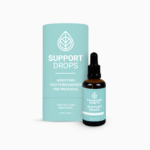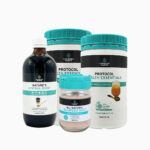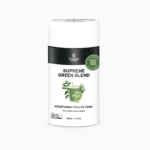News is sparse, TV non-existent, newspapers nowhere and not a glossy magazine in sight, no wi-fi nor internet or phone signal in Kaokoland, Namibia. As a result, it was a few days before I heard about the US FDA calling a ban on trans fats in the American food supply. All food manufacturers must comply by 2018.
Denmark banned this food long ago, so why are other countries so slow to catch on, including Australia?
So what’s a trans fat? A trans fat is found in nature – but in very small amounts -in animal products. The trans fat in question is different. It is the fat that is made when a polyunsaturated fat (that is normally a liquid at room temperature) goes through a process called partial hydrogenation. In other words, hydrogen is combined with the fat through a chemical process that was designed by a chemist working for Procter and Gamble in the 1920s in order to make a polyunsaturated liquid oil become a semi solid fat at room temperature.
When you completely hydrogenate (as opposed to partially hydrogenate) a polyunsaturated fat, it then becomes a saturated fat and a very hard fat at room temperature.
Procter and Gamble were soap and candle makers and it was in their best interest to find an alternative to animal fat to make their products. They needed a hard cheap fat that had an indefinite life span. The hydrogenation process was the answer to what they were looking for. As times changed and Procter and Gamble grew into a drug and chemical company, they realised the worth of the process of hydrogenation and partial hydrogenation and started into the food industry with Crisco Fat and then margarine and the rest is history.
The result of this process also resulted in a cheap replacement for butter, and that would be margarine, a so called food that defies time and never goes off. A food makers dream it is a very cheap commodity that has morphed with the times. But it’s a human body’s disaster.
The warning about this fat has been consistent. Scientists as early as the 1950s were seeing trans fat as a health hazard. Dr Mary Enig’s work was the first that I read on the topic. She warned about trans fats in the late 1970s – as a biochemist she was concerned about it in the food supply. By the time I’d finished university in the 1980s – where I learnt that margarine was a far healthier fat then butter – I knew the authorities had it all wrong. But who was I, fresh out of school and sprouting that butter was better?
I wrote an article for the Sunshine Coast Daily in 1991 regarding the dangers of margarine, which at that time had a high percentage of trans fats. The editor called me a couple of days after it went to print to say that the paper was being sued as a result of my article and would I retract my view. I said ‘no’. A compromise was met between the margarine association and the newspaper and the editor gave them a full-page spread advertisement on the health benefits of margarine.
Science has this uncanny ability to prove or disprove just about anything, so how do you know when it’s right or wrong? Students in my education course are learning this right now.
The first step is to have a philosophy and a stand about the food you eat and the way you live, that way you are not going to fall for every new beaut thing that comes along that says it is the latest and greatest for your heart health or your health in general.
Then it is about having some common sense. There are foods that cultures have lived on for eons, natural foods (not chemically manipulated foods) that have stood the test of time. I knew that butter, milk, cream, fermented dairy and cheeses had been a huge part of many cultures around the world for thousands of years and so, I reasoned, how could an old traditional food be causing a modern disease? With my education focused on cultural anthropology and nutrition, the hype about margarine just didn’t stack up, yet Dr Mary Enig’s warning about trans fats was duly noted and I found other supporting material to back up her argument.
The Australian Heart Foundation has supported margarine and trans fats right up until the last decade. I believe it was about 2006 that the front page of a national Australian newspaper headlines warned about trans fat.
The Heart Foundation, very quietly I’m sure, had talks with margarine association manufacturers asking them to change their formulations. I was watching the ingredients of margarine very closely during this time and I noticed that the content of saturated fat in margarine increased – no doubt due to the fact that instead of partially hydrogenating the polyunsaturated oil, they completely hydrogenated the oil, creating a very hard saturated fat and then adding back oil that was non hydrogenated in order to make the margarine a semi-soft product.
After a year or so I noted that the saturated fat had fallen in margarine and the Heart Foundation very smugly told everyone that all Australian margarine was non hydrogenated and with very little to no trans fats. They failed to tell the public what new process was being done to the polyunsaturated fat in order for it to be solid at room temperature.
The process that oil goes through to make margarine in Australia and other parts of the world is a process called interesterification. If this process isn’t used then another process called fractionation, with the help of solvents, might be used.
Interesterification creates a new fat not found in nature; it’s called an IF (Interesterified Fat). I’ve seen some research regarding this fat out of a university in Malaysia that noted that consuming an IF over a 4-week period caused a pre-diabetic state in participants. More research is needed of course, but let’s face it, industrial foods are extremely poor at being healthy and have not stood generations of survival, and I’m not going to be part of yet another human experiment. I’m hoping those that are reading this article will also stop the madness of thinking that foods that taste like food, look like food, smell like food but are not food are healthy and will prevent heart disease or any other disease for that matter. The Australian Heart Foundation tick of approval is littered with these foods.
So how do you know if a food you are eating has an industrial fat? Look for terms like this: vegetable oil, vegetable fat, hydrogenated fat, hydrogenated oil, partially hydrogenated oil or margarine. If it says it is an oil and it is solid, be very suspicious. If it has a life span longer than yours, once again beware. Even margarine you think is healthy because of the way it is marketed is still an industrial fat.
The best thing to do is make all your foods from scratch, read all your ingredients (not the nutritional label) if you are buying packaged foods and get back to basics. Reread Changing Habits Changing Lives as a lot of the information you will need to change your eating habits is in that book.
I also recommend you get my Cholesterol Scam Report as it not only talks about cholesterol but also the history of margarine and trans fats and how they have gripped the food manufacturing sector as well as becoming the darling of the medical doctors’ prescription when heart disease is diagnosed.
The banning of trans fats is just the beginning; it is one food that has been indicated to be a danger to our health. But there are so many more and they are usually the ones that come out of a chemical laboratory rather than from the land and the sea.
In a very short time we have seen the US ban trans fats and disregard any guidelines for cholesterol. In other words – they got it wrong – but in the meantime the health of many has suffered and deaths have occurred as a result of trans fat and the fear mongering around cholesterol. We have also seen this week New Zealand allow raw milk sales again. I’ll talk about that next week.
I’m looking forward to being in Adelaide over the weekend and imparting current knowledge about how to get back to vibrant, energetic, clear minded health. I can hardly wait.
Happy changing habits
Cyndi








0 Comments